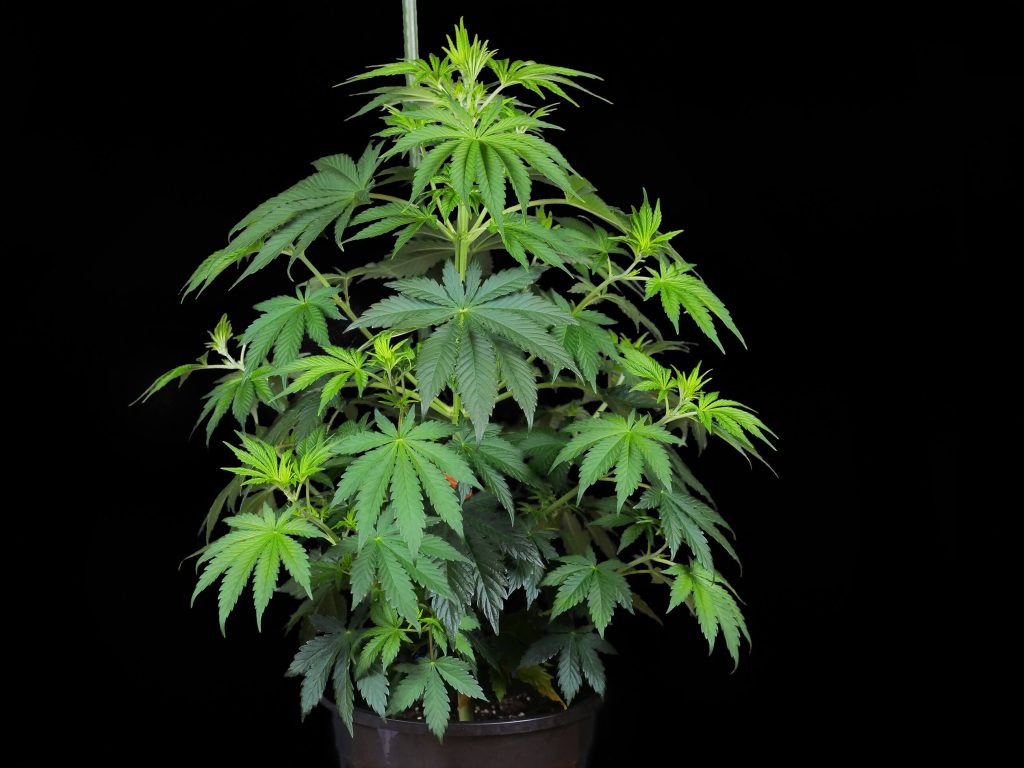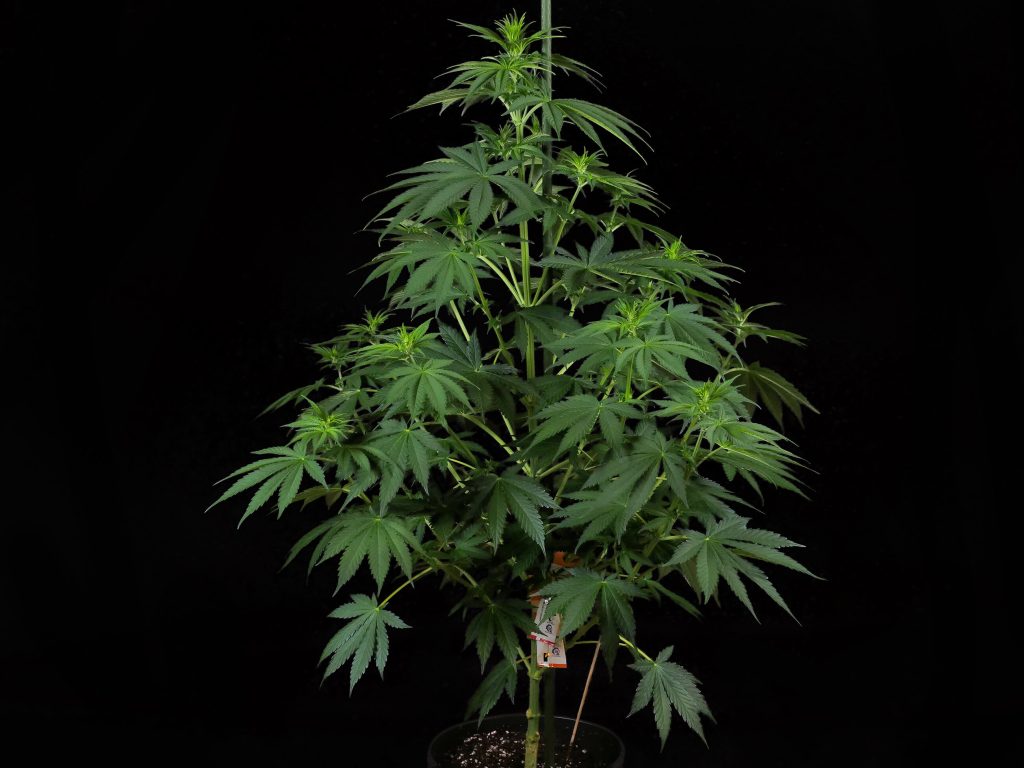Blackberry Cake Feminized is a sturdy, high-yielding plant for gardeners of all levels. We achieved an exceptional yield and were amazed at its cannabinoid content. Its exotic terpene profile offered a sweet earthy scent with zesty citrus and creamy dessert. With euphoric but relaxing effects, this strain is ideal for enjoying time with friends and family.
Flowering stage: 72 days
Total time, seed to harvest: 99 days
Final yield: 167 grams
THC content: 29.5%
Our latest grow report features Blackberry Cake Feminized, and we’re happy to share the details of one of our favourite plants to grow with you! The strain was created as part of our Research program, exclusively by Sensi Seeds. The genetics were masterfully selected from a cross of; Wedding Cake, Durban, and Black Domina.
Our Blackberry Cake Feminized was grown in our indoor growing area, using BAC Lava Mix soil, and fed Bio Grow and Bio Bloom nutrients. During our seedling and vegetative stage, our light schedule was 18 hours on / 6 hours off. This was changed to 12/12 during the flowering stage. Having feminized seeds worked to our advantage, and there was no need to sex them during early flowering.
A 1000W Green Power Phillips HPS bulb and reflector were hung from the ceiling three meters above the soil. Various oscillating fans were positioned at different heights to help circulate air within the grow room and canopy. An inline fan was added to exhaust the stale air from the grow space. The inline fan exhausted into a carbon filter, which removed odours emanating from the plants in the flowering stage.
We kept tight control of the environmental parameters. This ensured maximum growth efficiency and promoted the best yield possible. The grow room temperature was steady at 23°C during the day and 21°C at night. Humidity in the room was set at 65% to begin our grow, but was gradually reduced during flower.
Germination & seedling
We placed our Blackberry Cake Feminized seed into a pre-moistened jiffy pellet to germinate. As the cotyledon emerged from the hole, the jiffy pellet was moved into a 1-litre container of soil and placed 80 cm under a 600W Green Power Phillips HPS bulb.
Watering wasn’t required until the third day when we poured 100 ml of water and root stimulant; pH’d to 6.0, around the base of the stem, ensuring maximum uptake. The roots were young and hadn’t yet reached the edge of the container. By the end of the first week, our Blackberry Cake Feminized had reached 3 cm.
Vegetation
Week two was a busy week for our Blackberry Cake Feminized plant. The roots started to protrude from the bottom of our 1-litre pot, so we transplanted it into a 5-litre container. Now that some roots were established, we introduced Bio Grow into the feeding schedule with an EC of 1.4.
As part of our proactive IPM routine, we released two beneficial insect types to prevent outbreaks of thrips, fungus gnats, and two-spotted spider mites. The first, Neoseiulus Californicus, controls harmful mites, namely the two-spotted spider mite. The second beneficial insect was Amblyseius Swirskii, used against thrip and whitefly as a general predator.
In week three, our Blackberry Cake Feminized now stood at 20 cm and was developing a healthy root zone. We increased the water intake and gave our plant 200 ml of water applied directly around the stem. The plant has shown promising signs of progress and has already developed five nodes. Large, broad-bladed, emerald-green leaves reached out from each node towards the outer rims of our containers. The stem gained girth, and all indicators pointed to vigorous growth.
Flowering
By week four, our Blackberry Cake Feminized had reached a height of 32 cm. We knew this strain would explode with growth when transitioned into flower, so we decided to make the transition now and change the lighting schedule to 12 on / 12 off. This was also when we adjusted humidity levels, which were reduced to 60%.
We discontinued using the Bio Grow nutrients and transitioned to giving our Blackberry Cake Feminized plant Bio Bloom formula. The nutrients were added to our water, and we adjusted it to a final EC of 1.7 before applying it to the root zone. The watering volume increased to 400 ml, which was spread evenly over the soil’s surface in the container.
As predicted, towards the end of week five, our Blackberry Cake Feminized exploded with growth. It was now consuming water very fast and subsequently increased to volume to 800 ml, which provided a little more time in-between waterings. It is best not to wait until the leaves droop to water the plant; the goal is to be ahead of that point. The nutrients were bumped up, and the final solution had an EC value of 1.8 before application.
Many auxiliary limbs grew rapidly and now stood out from the main stem. The internodal spacing had remained tight, but each limb extended far enough to capture unblocked light. A few leaves on our Blackberry Cake Feminized had turned a lighter colour, but this was due to the fast growth. As they matured, they would turn a healthy emerald green.
My goodness! When we measured our Blackberry Cake Feminized in week six, it was 87 cm tall. That was a 30 cm increase from the week before. This was go-time. Our plant was hitting its stride. We increased the solution volume to 1500 ml per watering to support that growth. We adjusted the solution pH to 6.0, and the final EC was 1.8.
As a precaution against micro-climates forming in the under-canopy of the Blackberry Cake Feminized, we removed some of the extra growth. Lower branches and many of the larger sun leaves were removed. This opened up the structure of the plant and allowed more airflow. Removing lower limbs also helps divert growth potential to the upper limbs that receive more light.
It had been four weeks since we last released sachets of Neoseiulus Californicus and Amblyseius Swirskii. We had not noticed any pest damage to our Blackberry Cake Feminized, but that doesn’t mean the potential didn’t exist. To mitigate that potential against thrips, fungus gnats, two-spotted spider mites and more, we placed another sachet of each beneficial insect on our plant.
In week seven, our Blackberry Cake Feminized continued to thrive in the conditions we provided. We registered another 25 cm of growth and saw the emerging stigmas form into small puffballs that would later form buds. To anticipate for bud-development, we used gardener’s stakes to help support the weight.
As we have been using large concentrations of supplements, we started this week by flushing our medium. Running the pure water through the soil removes built-up salts and excess nutrients. After the flush, we resumed regular feeding with nutrients for the remainder of the week.
By week eight, our Blackberry Cake Feminized now stood 147 cm tall. That was nearly five times the height when we placed her into flower. A significant part of this growth was that the structure remained tight. There were now dozens of branches with multiple bud sites on each. Blackberry Cake Feminized has the potential for an excellent yield, and we managed to flip our plant into flower at the perfect time.
In week nine, the vertical growth had almost stopped. Our Blackberry Cake Feminized was now working full-time to grow and stack flowers. A few lower limbs were not reaching high enough to get unobstructed light, so we removed them, sending more energy to the upper limbs for optimal growth. Our Blackberry Cake Feminized had a massive terminal cola that towered above the lower canopy. We knew that this Blackberry Cake Feminized still had several weeks of growth remaining, and to our delight, there was no exposed stem; the buds had already filled in the internodal gaps.
In week ten, while scouting our Blackberry Cake Feminized plant as part of our regular IPM routine, we determined that the foliage was still too thick, and we removed a few more auxiliary branches and more fan leaves.
The buds were becoming denser, and removing excess foliage helped improve airflow within the canopy, reducing the potential for botrytis. We also reduced the humidity in the room to 56%. It had been four weeks since we released Neoseiulus Californicus and Amblyseius Swirskii, so to be thorough, we hung another sachet of each on the lower branches.
We started week eleven by flushing the soil using pure water and disposing of the run-off. After the flush, we continued with regular feeding at 1.8 EC. The side branches were now beginning to fall over under the pressure of the developing buds and used more stakes to support the branches.
Week twelve marked the first time we experienced a distinct and identifiable odour as we entered the growing area. Our Blackberry Cake Feminized was letting out a pungent floral scent that filled the air. Thanks to the extraction fan and carbon scrubber, you couldn’t detect the odour outside the grow room.
Vertical growth had stopped, and the dense buds were now stacking up on each other. This gave the flowers an open structure favoured by extraction artists. The majority of stigmas were still whites, but we did detect some swelling in the bracts, which is an indicator of an upcoming harvest.
Week thirteen began by using a jeweller’s loupe to inspect the trichome heads to help guide us on when to harvest. After inspecting buds from the plant’s upper, middle, and lower portions, we determined that this plant was likely to reach peak ripeness within the next 14 days. We saw mainly milky heads, with roughly 12-13% clear and 7-8% amber. Within the next two weeks, the clear and amber heads would likely become an even ratio, and that is when we wanted to harvest.
The goal is to let the plant consume all stored nutrients before harvest, which is thought to create a smoother taste during consumption. We eliminated our Bloom nutrients in the final weeks and used pure water at every feeding. This would help wash excess nutrients from the soil and cause the plant to rely on its stored nutrients.
The final week for our Blackberry Cake Feminized was week fourteen. Towards the end of the week, our efforts to flush the soil were visible on the leaves. Once an emerald green, the large fan leaves now exhibited a yellowish tint indicating a lack of nutrients. The stigmas had mainly retreated into the swollen, trichome-covered bracts.
The desired ratio of 80% milky, 10% clear, and 10% amber trichomes head is what we found when inspecting flowers from a few areas of the plant. Over this past week, the floral scent grew louder, and after 99 days, we decided to harvest the Blackberry Cake Feminized.
Harvest
Controlling the environment in your drying area is one of the most critical steps post-harvest. Throughout our 14-day drying period, the temperature was a steady 15.5°C with a humidity level of 60%. All large fan leaves were removed to avoid excess moisture, and the plant was hung upside-down in complete darkness. Oscillating fans were used to move air throughout the branches, avoiding the build-up of moisture and the conditions of the dry room were checked multiple times daily.
If the flower contains high levels of moisture before it’s jarred, then it could increase the probability of botrytis, whereas If the flower is too dry, it is hard to rehydrate. After the first close inspection, we felt it would still be a few more days until the Blackberry Cake Feminized buds would be in the desired range. By day 18, the moisture levels were where we wanted them, and it was time to trim!
Once our gloves were on, branches were removed, leaving enough stem to comfortably trim the flowers without touching them. Trimmed buds were placed loosely into the glass mason jar, and the lids were left off for the first 36 hours to begin the curing process, which helped remove excess moisture. Excess trim was collected to make hash with.
Although the centre of the buds retained moisture, the outside layer was slightly crispy before we sealed the jars. For the first two weeks, the jars were opened several times a day and vented for one hour at a time. Every time one of the jars was opened, an increasingly sweet and pungent floral scent would fill the room. For the following four weeks, each jar was opened for an hour daily, and we were looking for optimal humidity levels of between 55 and 65%.
A sample was sent to a third-party laboratory for cannabinoid testing, and we were astonished when its THC levels were recorded at 29.5% THC. High-yielding and potent, Blackberry Cake Feminized is an excellent addition to any garden!
Terpene profile
Blackberry Cake Feminized exhibited a variety of flavour profiles throughout each stage of the cultivation cycle. The scent was mild until the final three weeks of flower when it developed a floral bouquet. It’s not uncommon for the terpene profile to mature throughout the drying and curing stages. As the plant was hanging, an earthy tone began to intertwine with the pungent floral aroma.
When we opened the jar after the six-week cure, several aromas greeted our receptors, and each had a boldness that gave the overall profile richness. Detectable were loud earthy notes combined with subtle hints of pine, slight floral notes could be detected in the background. One surprising addition to the terpene profile was the refreshing citrus scent that developed during the cure.
Our Blackberry Cake Feminized had a delightful taste worthy of the its name. The depth of the flavour profile took us by surprise. There is a layer of creaminess in the flavour of Blackberry Cake Feminized that makes it feel like an indulgent treat. Finally, a hint of spice adds some balance to the sweet and citrus flavour palate.
Effects from our Blackberry Cake Feminized could best be described as relaxing with a gentle sense of euphoria, and demonstrated effects from both the indica and sativa lineage. Some people reported an increased sense of creativity, but overall, the effects were uplifting and comforting.
The outcome
Blackberry Cake Feminized was an undemanding, easy-to-grow plan, with a duration of 99 days from seed to harvest. We loved that the seeds were feminized, which allowed us to save time on sexing! It was a heavy-yielding plant, and produced excellent buds from top to bottom. Bracts stacked on each other to create trichome-covered towers that topped each of the dense flowers.
Our Blackberry Cake Feminized, reached a height of 147 cm, and once our flowers were cured, we weighed our harvest and produced 167 grams of consumable flowers. The effects were substantial, and a third-party laboratory confirmed that our Blackberry Cake Feminized had a THC level of 29.5%. If growers have been looking for a fun and easy-to-grow strain that produces large yields and strong effects, Blackberry Cake Feminized is the right choice.
Do you have a strain that you want to see us do a grow diary for? Drop your suggestions in the comments below. Until then, have fun in the garden!
-
Disclaimer:Laws and regulations regarding cannabis cultivation differ from country to country. Sensi Seeds therefore strongly advises you to check your local laws and regulations. Do not act in conflict with the law.
- SEO Powered Content & PR Distribution. Get Amplified Today.
- EVM Finance. Unified Interface for Decentralized Finance. Access Here.
- Quantum Media Group. IR/PR Amplified. Access Here.
- PlatoAiStream. Web3 Data Intelligence. Knowledge Amplified. Access Here.
- Source: https://sensiseeds.com/en/blog/blackberry-cake-feminized-grow-report/
- :has
- :is
- :not
- :where
- $UP
- 1
- 100
- 12
- 14
- 15%
- 167
- 20
- 200
- 25
- 30
- 32
- 7
- 72
- 8
- 80
- 87
- a
- above
- achieved
- Act
- added
- addition
- Adds
- Adjusted
- ADvantage
- After
- against
- ahead
- AIR
- All
- already
- also
- amber
- an
- and
- Another
- anticipate
- any
- Application
- applied
- Applying
- AREA
- areas
- around
- Artists
- AS
- At
- auto
- avoid
- avoiding
- background
- Balance
- BE
- become
- becoming
- been
- before
- began
- begin
- Beginning
- below
- beneficial
- BEST
- between
- Bloom
- both
- Bottom
- branches
- busy
- but
- by
- CAKE
- Cannabinoid
- cannabis
- Canopy
- capture
- carbon
- Cause
- ceiling
- centre
- change
- changed
- check
- checked
- choice
- clear
- Close
- cola
- combined
- comments
- complete
- conditions
- CONFIRMED
- conflict
- consume
- consumption
- Container
- Containers
- contains
- content
- continued
- control
- controls
- could
- country
- create
- created
- critical
- Cross
- cultivation
- cure
- curing
- cycle
- daily
- damage
- day
- Days
- decided
- delight
- delightful
- demonstrated
- depth
- described
- desired
- details
- detected
- determined
- developed
- developing
- DID
- differ
- different
- directly
- distinct
- do
- Doesn’t
- dozens
- Drop
- dry
- due
- duration
- during
- each
- Early
- EC
- Edge
- effects
- efficiency
- efforts
- eliminated
- Emerald
- emerged
- emerging
- end
- energy
- enough
- ensuring
- entered
- Environment
- environmental
- established
- Ether (ETH)
- Even
- evenly
- Every
- excellent
- exceptional
- excess
- exclusively
- exist
- Exotic
- experienced
- exposed
- extra
- extraction
- Fall
- family
- fan
- fans
- far
- FAST
- Features
- Fed
- feeding
- feel
- few
- fill
- filled
- filter
- final
- Finally
- First
- first close
- first time
- five
- Flip
- flower
- following
- For
- form
- formula
- found
- four
- friends
- from
- fun
- gained
- gaps
- gave
- General
- Genetics
- gentle
- get
- Giving
- glass
- goal
- gradually
- Grams
- Green
- green power
- greeted
- Grow
- growers
- Growing
- grown
- Growth
- growth potential
- guide
- had
- happy
- Hard
- harmful
- harvest
- Have
- having
- head
- heads
- healthy
- height
- heights
- help
- helped
- helps
- her
- High
- hints
- hitting
- Hole
- hour
- HOURS
- HTTPS
- ideal
- if
- improve
- in
- Increase
- increased
- increasingly
- indicating
- Indicator
- Indicators
- into
- introduced
- IT
- ITS
- jpg
- kept
- laboratory
- Lack
- large
- Last
- later
- latest
- LAVA
- Law
- Laws
- Laws and regulations
- layer
- leaving
- left
- letting
- Level
- levels
- light
- lighter
- Lighting
- like
- likely
- little
- local
- looking
- loved
- lower
- Main
- mainly
- Majority
- make
- MAKES
- managed
- many
- marked
- Mason
- massive
- mature
- max-width
- maximum
- mean
- measured
- medium
- Middle
- mild
- Mitigate
- mix
- ML
- more
- most
- move
- moved
- multiple
- name
- namely
- nearly
- Need
- next
- night
- no
- node
- nodes
- now
- of
- off
- offered
- on
- once
- ONE
- open
- opened
- optimal
- Other
- our
- out
- outside
- over
- overall
- parameters
- part
- past
- Peak
- People
- perfect
- period
- plan
- plants
- plato
- Plato Data Intelligence
- PlatoData
- Point
- positioned
- possible
- pot
- potential
- power
- predator
- predicted
- pressure
- prevent
- Proactive
- probability
- process
- Produced
- produces
- Profile
- Profiles
- Progress
- promising
- Promoted
- provided
- range
- rapidly
- ratio
- reach
- reached
- reaching
- receive
- recorded
- Reduced
- reducing
- regarding
- registered
- regular
- regulations
- released
- rely
- remained
- remaining
- remove
- Removed
- removing
- report
- Reported
- required
- right
- Room
- root
- roots
- roughly
- running
- Save
- saw
- schedule
- Second
- see
- seed
- seeds
- selected
- sending
- sense
- sent
- set
- seven
- several
- Sex
- Share
- shown
- side
- significant
- Signs
- since
- Sites
- small
- smoother
- So
- soil
- solution
- some
- Space
- spice
- spread
- stack
- stacked
- stacking
- Stage
- stages
- started
- steady
- Stem
- Steps
- Still
- stopped
- stored
- stride
- strong
- strongly
- structure
- sturdy
- Subsequently
- substantial
- Sun
- support
- Surface
- surprise
- surprising
- sweet
- taste
- Terminal
- Testing
- thanks
- that
- THC
- The
- the Law
- Them
- then
- There.
- therefore
- they
- Third
- third-party
- this
- this week
- thought
- three
- Thrive
- Through
- throughout
- time
- times
- to
- TONE
- too
- took
- top
- topped
- touching
- towards
- transition
- treat
- TURN
- Turned
- two
- types
- Uncommon
- under
- until
- upcoming
- us
- used
- using
- value
- variety
- various
- vertical
- very
- visible
- volume
- wait
- want
- wanted
- was
- Water
- watering
- we
- week
- Weeks
- weight
- were
- What
- when
- whereas
- which
- while
- with
- within
- without
- worked
- working
- would
- yet
- Yield
- yields
- you
- young
- Your
- zephyrnet


















